A Linen Service Specialist – Efficiency and Cost Reduction Achieved with ZESTOS System
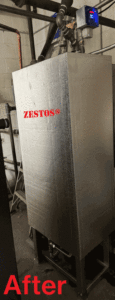
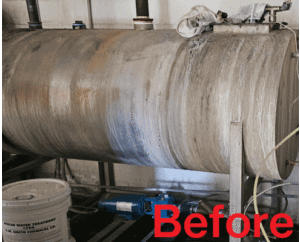 Background: A linen service provider, utilizing a 50 horsepower steam boiler, encountered significant challenges with their water treatment process. Overuse of boiler water treatment chemicals led to these chemicals being ejected with steam through recovery tank vents, causing pollution and inefficiency. The boiler feedwater temperature was maintained at around 120°F, which was less than ideal for optimal operations.
Background: A linen service provider, utilizing a 50 horsepower steam boiler, encountered significant challenges with their water treatment process. Overuse of boiler water treatment chemicals led to these chemicals being ejected with steam through recovery tank vents, causing pollution and inefficiency. The boiler feedwater temperature was maintained at around 120°F, which was less than ideal for optimal operations.
Implementation: The installation of the ZESTOS system marked a pivotal improvement. With the system in place, the boiler feedwater temperature soared to approximately 210°F. This increase in temperature not only enhanced the efficiency of steam generation but also addressed the critical issue of chemical spillage.
Outcomes:
- Improved Operational Efficiency: The ZESTOS system facilitated a significant increase in boiler feedwater temperature, leading to a more efficient steam generation process.
- Cost Reduction: Boiler water treatment costs were dramatically reduced by 95%, showcasing the system’s ability to enhance operational cost-effectiveness.
- Energy Savings: The facility experienced energy savings of around 9%, contributing to both environmental sustainability and reduced operational costs.
- Elimination of Chemical Spillage: The problematic expulsion of treatment chemicals with steam was completely eradicated, resulting in a cleaner, safer, and more compliant operation.
- Enhanced Steam Quality: The quality of steam produced was significantly improved, positively affecting the overall service quality provided to customers.
Conclusion: The ZESTOS system has proven to be an invaluable asset for the linen service specialist, addressing both environmental and operational challenges. By significantly increasing feedwater temperatures and eliminating chemical spillage, the system not only saved costs but also improved the quality of steam, demonstrating a clear return on investment.
A Dry Cleaning Operation – Transforming Boiler Efficiency and Environment
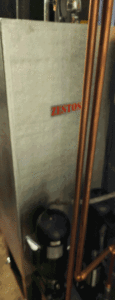
 Situation Before ZESTOS Implementation: A dry cleaning business operating with two 50 horsepower boilers faced significant operational challenges. A considerable volume of steam was returning to the boiler return tank, causing steam to pervade the boiler room. This not only resulted in a perpetually wet floor but also contributed to severe rusting of the boiler equipment. The temperature of the boiler feedwater was maintained at around 140°F, indicating inefficiency in the system’s operation.
Situation Before ZESTOS Implementation: A dry cleaning business operating with two 50 horsepower boilers faced significant operational challenges. A considerable volume of steam was returning to the boiler return tank, causing steam to pervade the boiler room. This not only resulted in a perpetually wet floor but also contributed to severe rusting of the boiler equipment. The temperature of the boiler feedwater was maintained at around 140°F, indicating inefficiency in the system’s operation.
Implementation of the ZESTOS System: The introduction of the ZESTOS system into the facility’s operations brought about substantial improvements. By optimizing the process and enhancing the control of steam and feedwater temperatures, the ZESTOS system elevated the boiler feedwater temperature to approximately 209°F. This adjustment had a profound effect on the operational environment and efficiency.
Outcomes of the ZESTOS System Installation:
- Enhanced Operational Environment: The installation of the ZESTOS system resolved the issue of excess steam in the boiler room, resulting in a dry and improved working environment.
- Increased Energy Efficiency: The business realized energy savings of approximately 7%, indicating a more efficient use of resources and a reduction in operational costs.
- Improved Equipment Longevity: With the elimination of excessive moisture and the associated rusting issue, the lifespan of the boiler equipment is expected to increase, further adding to the cost-effectiveness of the operation.
Conclusion: The deployment of the ZESTOS system in the dry cleaning facility’s operations has not only mitigated previous challenges but also enhanced overall efficiency. The significant increase in boiler feedwater temperature, coupled with the dry and improved operational environment, underscores the system’s value in optimizing steam boiler operations.
Enhancing Efficiency and Reducing Maintenance Costs at a Tofu Factory with ZESTOS System
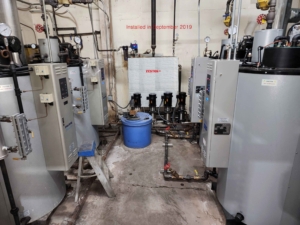 Background: A tofu manufacturing facility utilized four 24 horsepower boilers as an integral part of their production process. A major challenge encountered was the absence of return steam in the boiler feedwater tank, resulting in a low feedwater temperature of 70°F. This condition led to frequent rusting of the boiler water tubes, necessitating their annual replacement, and frequent breakdowns of the pump system, contributing to high maintenance costs and operational downtime.
Background: A tofu manufacturing facility utilized four 24 horsepower boilers as an integral part of their production process. A major challenge encountered was the absence of return steam in the boiler feedwater tank, resulting in a low feedwater temperature of 70°F. This condition led to frequent rusting of the boiler water tubes, necessitating their annual replacement, and frequent breakdowns of the pump system, contributing to high maintenance costs and operational downtime.
ZESTOS System Implementation: The introduction of the ZESTOS system was a strategic move to address these inefficiencies. With its installation, the boiler feedwater temperature experienced a significant increase, reaching approximately 205°F. This improvement not only optimized the operational efficiency but also had a profound impact on the maintenance and longevity of the boiler components.
Outcomes:
- Elimination of Rust: The persistent issue of rust on the boiler tubes and drum was completely resolved, eliminating the need for their costly annual replacement.
- Increased Pump Durability: The installation of the ZESTOS system, coupled with the use of Grundfos pumps, resulted in a marked increase in pump longevity, reducing the frequency of breakdowns and associated repair costs.
- Optimized Boiler Feedwater Temperature: Elevating the feedwater temperature to 205°F significantly enhanced the boilers’ efficiency and operation, contributing to a more stable and reliable production process.
Conclusion: The implementation of the ZESTOS system in the tofu factory has demonstrated its value in increasing operational efficiency, reducing maintenance costs, and enhancing equipment longevity. By addressing the critical issues of low feedwater temperature and equipment corrosion, the ZESTOS system has proved to be an essential solution for ensuring the sustainable operation of boiler systems in industrial settings.
Enhancing Efficiency in Professional Uniform Cleaning with the ZESTOS System
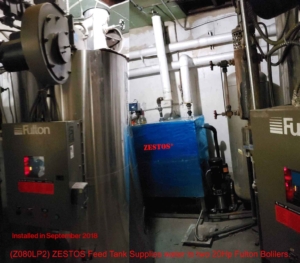 Challenge: Prior to the adoption of the ZESTOS system, our client’s professional uniform cleaning operation was severely impacted by an overabundance of return steam. This problem was so acute that it mimicked indoor rainfall, significantly dampening the facility. Moreover, the boiler feedwater’s temperature was consistently low, around 100°F, contributing to inefficiencies in steam generation.
Challenge: Prior to the adoption of the ZESTOS system, our client’s professional uniform cleaning operation was severely impacted by an overabundance of return steam. This problem was so acute that it mimicked indoor rainfall, significantly dampening the facility. Moreover, the boiler feedwater’s temperature was consistently low, around 100°F, contributing to inefficiencies in steam generation.
Solution: The integration of the ZESTOS system into our client’s facility brought about revolutionary improvements. Notably, the temperature of the boiler feedwater surged to approximately 208°F—a remarkable increase of 108°F. This adjustment directly tackled the issue of excess return steam.
Results: Through strategic management of the return steam, our client achieved an impressive energy saving of about 11%. This not only enhanced operational efficiency but also markedly improved the work environment, making it substantially more comfortable and conducive to productivity.
Conclusion: The ZESTOS system has proven to be an indispensable solution for overcoming the challenges of excessive return steam and low feedwater temperatures. By significantly improving both energy efficiency and the workplace atmosphere, it stands as a testament to the value it brings to professional uniform cleaning facilities.
